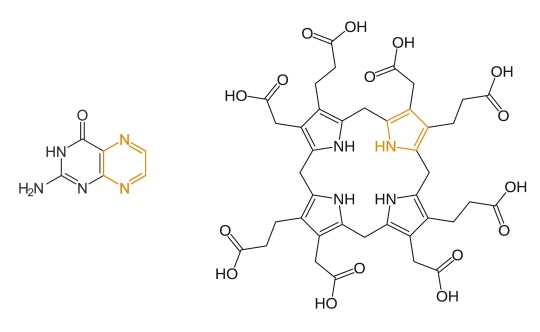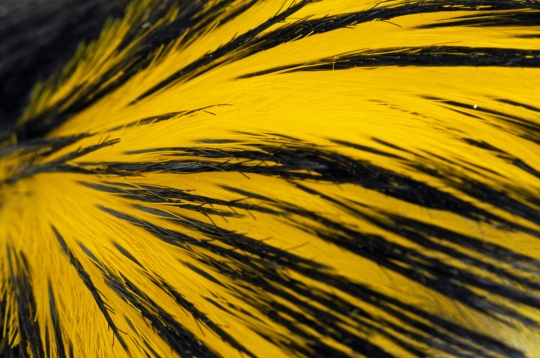#An ancient penguin with yellow feathers
Heard Island emerged from the Indian Ocean millions of years ago and is now savaged by snow and battered by wind. The island is among the most remote places on Earth and our record of its existence only began in the mid 19th century. Victorian-era access to Heard Island was by schooner or barque, from a harbour on the Kerguelen Islands 450 km away. In 1874 a collection of Heard Island wildlife was brought to the Kerguelen Islands and given to the crew of the visiting USS Swatara. The animals from this remote wilderness were passed along to Dr. Jerome Kidder, surgeon and naturalist for Swatara. Kidder prepared and studied the specimens, and 17,000 km away in Washington, DC, he stored the bounty at the Smithsonian Institution.
The specimens from Heard Island included this macaroni penguin:
The penguin that Dr. Kidder brought back from Heard Island has recently helped us with an interesting feather colour puzzle (Thomas et al. 2013). Yellow is a very common feather colour and is achieved in a variety of ways. For example, a canary will eat seeds that contain yellow pigments, and those pigments will be deposited in feathers. A parrot will use biochemical pathways to make yellow pigments while the feather is growing. The yellow pigment in penguin feathers is… a mystery. By studying yellow penguin feathers we could not only learn about the pigment chemistry, but we could also discover when the pigment first evolved and which fossil penguins had yellow feathers.
Raman spectroscopy has given us some new insight into the chemistry of the yellow penguin pigment. As mentioned elsewhere in this blog, Raman spectroscopy describes interactions between atoms in molecules or minerals. A Raman spectrum is a set of bands (or peaks…), and each band describes the energy of a particular atomic interaction. For example, a Raman spectrum of bone contains a band at 960 cm-1, and that band relates to an interaction between phosphorus and oxygen atoms. The Raman spectrum from the penguin pigment was brand new; it is not like anything that we have found in the published literature, and it is completely different from other feather pigments. The spectrum contains important bands at 1578, 1491, 1285 and 683 cm-1, which are hallmarks for a nitrogen-bearing, heterocyclic aromatic ring.

Nitrogen-bearing aromatic heterocyclic rings, highlighted in orange and shown in a pterin (left) and a porphyrin (right). Our best guess at this stage is that the penguin pigment contains something similar. Images adapted from Wikimedia Commons.
We still need more information before we can completely solve the structure, but at this stage we know for certain that the pigment is unlike anything so far observed in nature, and it is not likely to be a pigment that the penguins are eating. This means that penguins have evolved a biochemical pathway for making the pigment themselves. Armed with this new knowledge, we can look at the evolutionary history for the yellow penguin pigment. We do this by lining up the relevant evidence. First, we know that ten species of living penguin make the yellow pigment, including king penguins, yellow-eyed penguins and macaroni penguins. Second, we have a good idea that all living penguins are the descendants of an ancestor that lived more than 13 years ago (Ksepka and Thomas, 2012). Third, only penguins have this yellow pigment, and it is absent from albatrosses, shearwaters or petrels. This means:
1) Living penguins inherited the yellow pigment from the ancestor that lived 13 years ago.
2) The yellow pigment evolved after penguins had separated from albatrosses, petrels and shearwaters, at least 62 million years ago (Slack et al. 2006).
So the yellow penguin pigment is ancient, evolving sometime between 62 and 13 million years ago. We can use this information to add colour to an ancient penguin from South America.
Madrynornis mirandus (the ‘wonderful bird of Madryn’) is a 10 million year old penguin from Argentina (Acosta Hospitaleche et al. 2007). Madrynornis is more closely related to crested-penguins, like Kidder’s macaroni penguin, than any other group of penguins that we know of. Yellow-eyed penguins are also close relatives of both Madrynornis and the crested penguins, and all three groups shared a common ancestor that probably lived between 10 and 13 million years ago. We know that two of the groups descended from this common ancestor now have yellow feathers (crested and yellow-eyed penguins), so this means that the common ancestor probably had yellow feathers. And, because Madrynornis is a descendant of a penguin with yellow feathers, it very likely had them as well.
So, using Raman spectroscopy of modern feathers, we can add yellow pigments to Madrynornis mirandus, a 10 million year old penguin.

Image credits: Yellow-eyed penguin photo from Christian Mehlfuhrer, Macaroni penguin photo from Liam Quinn, Madrynornis images from Acosta Hospitaleche et al. 2007.
Acosta Hospitaleche C, Tambussi C, Donato M, Cozzuol M. 2007. A new Miocene penguin from Patagonia and its phylogenetic relationships. Acta Palaeontologica Polonica 52, 299-314.
Ksepka DT, Thomas DB. 2012 Multiple Cenozoic invasions of Africa by penguins (Aves, Sphenisciformes). Proceedings of the Royal Society B 279, 1027–1032.
Slack K, Jones C, Ando T, Harrison G, Fordyce RE, Arnason U, Penny D. 2006. Early penguin fossils, plus mitochondrial genomes, calibrate avian evolution. Molecular Biology and Evolution 23, 1144–1155.
Thomas, DB, McGoverin CM., McGraw KJ. James HF, Madden O. 2013. Vibrational spectroscopic analyses of unique yellow feather pigments (spheniscins) in penguins. Journal of the Royal Society Interface (doi: 10.1098/rsif.2012.1065)
Image links: macaroni penguin, Madrynornis mirandus, porphyrin, pterin, yellow-eyed penguin
P.S. We called the Raman spectrum ‘spheniscin’, and eventually we adopted this as the name for the pigment. Unfortunately, this was a very embarrassing mistake. A quick google search will show that the name ‘spheniscin’ has already been taken, and I will make sure this mistake is formally corrected in a follow-up publication.
